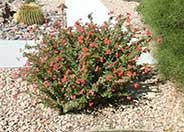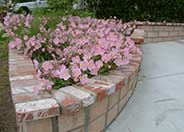
Common name:Dusty Miller, Silver Groundsel
Botanical name:Senecio cineraria
The Dusty Miller exhibits growth to 1' or more, with velvet gray leaves that have broad, roundish lobes. Yellow flower heads appear through the middle of the plant during most months of the year. Cut heads back occasionally to encourage bushiness.

Common name:Sundrops
Botanical name:Calylophus hartwegii
This low-growing perennial grows 2' x 3' and has woody stems with bright green leaves. It produces large, lemon yellow flowers that are up to 4" across and bloom spring through summer.

Common name:California Poppy, Golden Poppy
Botanical name:Eschscholzia californica
This small annual (sometimes acts as a perennial) plant will grow to less than 1' tall and has light, small blue green leaves with gold and orange flowers that bloom in spring and summer.

Common name:Red-Edged Chevron Plant
Botanical name:Dracaena marginata
This shrub will grow 6'-12' tall and has large, evergreen, leathery greenish red leaves.

Common name:Crown Of Thorns
Botanical name:Euphorbia milii
This woody shrub will grow 1'-4' tall and has brown gray stems with bright green leaves and bright red flowers on top. It is covered with long sharp thorns. It will do well in partial shade to full sun and dry soil.

Common name:Pink Mexican Evening Primrose
Botanical name:Oenothera speciosa 'Roseum'
Oenothera speciosa 'Rosea' is a perennial ground cover. It grows 10"-12" high, with profuse showing of 1.5" wide rose pink blooms in summer. Flowers open in daytime and stems die back after bloom. It can be highly invasive.

Common name:California Sagebrush
Botanical name:Artemisia californica
The California sagebrush is an evergreen medium sized, gray green aromatic shrub. The foliage has wispy soft texture.This shrub is native to CA, is drought tolerant, and attracts butterflies. This is a highly combustible plant.
Designer: Terry LePage
Photographer: GardenSoft
Incorporate compost 6" into your soil to retain water, reduce compaction, feed earthworms, and provide valuable nutrients to your plants.
Remove irrigation water and fertilizer from areas where you don't want weeds to grow.